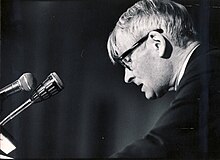Jens Arup Seip
| Jens Arup Seip | |
|---|---|
 |
|
| Born |
11 October 1905 Bolsøy |
| Died | 5 September 1992 (aged 86) Bærum |
| Citizenship | Norwegian |
| Scientific career | |
| Fields |
medieval history political history history of ideas |
| Institutions |
University of Oslo lecturer 1946–1952 professor 1952–1975 |
| Notable students |
Anne-Lise Seip, his later wife |
| Influences | Edvard Bull, Jr. |
Jens Lauritz Arup Seip (11 October 1905 – 5 September 1992) was a Norwegian historian originally trained as a medieval historian, but stood out as the strongest of his time in interpreting Norwegian political history in the 1800s, particularly known for having created the term "embedsmannsstaten". He was a professor at the University of Oslo from 1952 to 1975, he specialized in political history and the history of ideas. He was married to fellow historian Anne-Lise Seip. Seip's use of the Norwegian language and his writing style which numerous historians have described as brilliant, and often tried emulating. Seip was included among the 16 authors of " The Norwegian literary canon" from 1900 to 1960 and 2nd among 20 authors in a ranking of nonfiction writers conducted by Dagbladet in 2008. Seip received an honorary doctorate at the University of Bergen from 1975.
Jens Arup Seip was born in Bolsøy, near Molde. He was a descendent of military officer and politician Andreas Martin Seip (1790–1850). Andreas' grandson Jens Laurits Arup Seip, brother of politician Karl Seip, was the father of academic Didrik Arup Seip and politician Hans Kristian Seip, the latter being the father of Jens Arup Seip. Jens Arup Seip was also a first cousin of the forester and state secretary Hans Kristian Seip, and a second cousin of politician Helge Seip and physician Martin Fredrik Seip, who were grandnephews of Jens' grandfather Jens Laurits.
Jens Arup Seip was married to teacher and painter Rachel Lehre Seip (1931–1960) and had three children, Hans Christian, Morten and Knut, then to historian Anne-Lise Seip, whom he met while she was a student at the University of Oslo. The couple lived at Høvik in Bærum, and had two children, Ingebjørg and Åsmund, both of whom are academics. He died in September 1992 in Bærum.
...
Wikipedia
